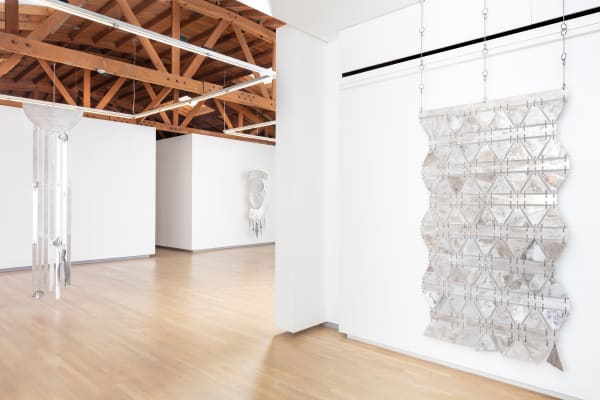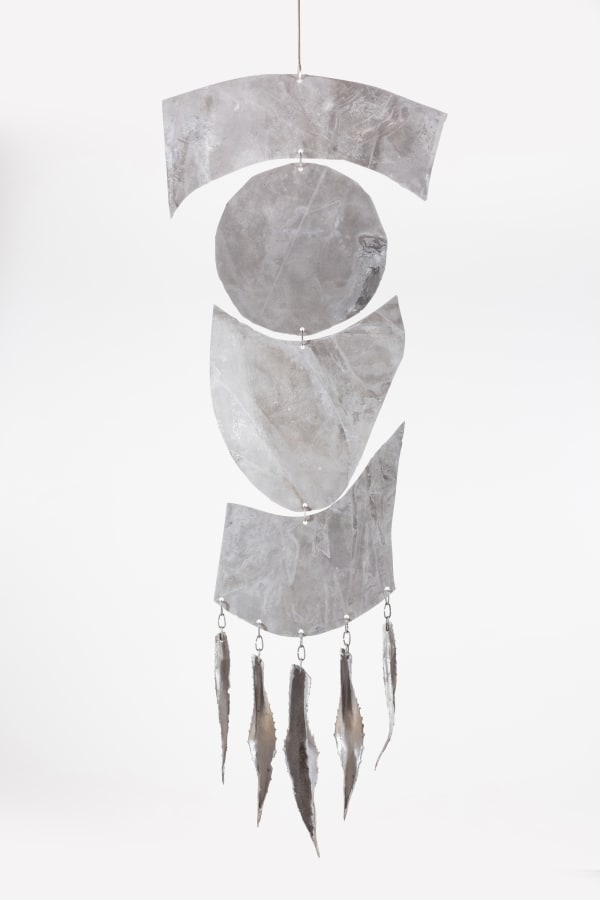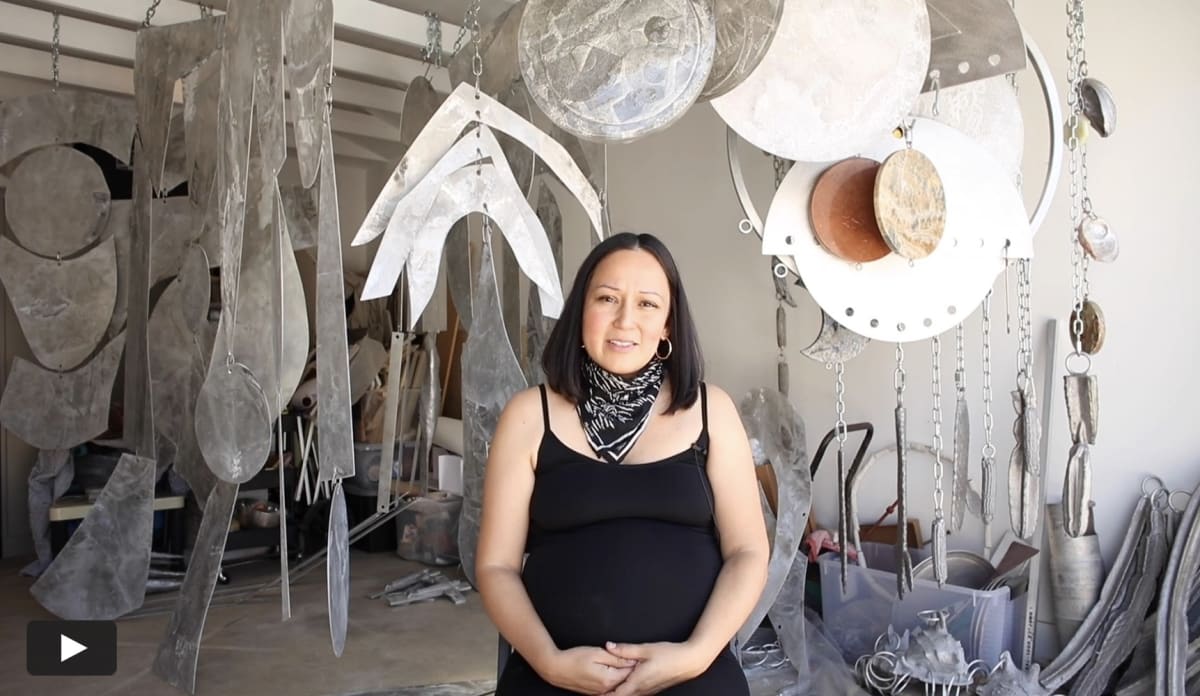Fay Ray: Lacuna
Shulamit Nazarian is pleased to present Lacuna, a series of new sculptures by Los Angeles-based Fay Ray. This will be the artist’s second solo exhibition with the gallery.
Lacuna continues the artist’s exploration of sculpture that exists between the terrestrial and the intangible. Through a vocabulary of symbols, the artist utilizes industrial materials to explore a wide range of references––from desert culture, to her familial and religious roots––while employing abstraction to transcend their material origins. Through the use of mass, scale, and medium, Ray’s suspended sculptures elicit the body as they react to the conditions of their environment, causing them to shift, enlarge, or disappear in the space. Slipping between presence and absence, this new series not only signifies a body that isn’t seen, but one that is endlessly contracting and expanding.
The exhibition’s title derives from the Latin word for lake, and can be understood as a gap, vacancy, or absence that is made known through its surroundings. Just as a body of water indicates an unseen impression in the earth, a Lacuna is an absence that is only revealed through another presence. Similarly, throughout the exhibition, objects and forms that appear absent or concealed are later revealed. As the artworks turn or the viewer’s sight line moves, positive and negative spaces in the sculptures are presented with each change in position. In other artworks, absence is conjured through division. Singular metal forms are bisected so that their shapes are shared between sculptures, the halved material suggesting an enigmatic whole--like the sever of a pill along its groove, or the split of the sun as it slips past the horizon.
The works in Lacuna amalgamate signs of land and sea. Returning to the High Desert in Southern California where the artist grew up, Ray has collected a variety of organic and non-organic material from the region. These artifacts are intimately linked to her familial past and serve as talismans. Each object is imbued with human touch, a specific location, and a certain passage of time, expanding the presence of these relics beyond their material properties. The artist gives equal attention to the industrial trucking equipment and metal scraps of her family’s multi-generational hauling trade, the woven baskets and abalone displays found in the homes of her youth, and to the corn, cacti, and seashells found naturally in the desert landscape. Ray’s objects are cast in aluminum, simultaneously immortalizing and memorializing these forms in a new material. Once preserved, these amulets are hand-fastened to sheet metal with the artist’s individually hand-formed chain links, leveling the symbol’s power through interchangeability, like charms on a bracelet.
Throughout the exhibition, moments of scale and material are met with spaciousness and lightness. The suspended and wall-mounted artworks of cast and machined aluminum are punctuated with natural materials such as stone, driftwood, and glass, and resemble an oversized body adornment such as a necklace, earring, or keychain. The razor-thin aluminum forms remain static, until a body, change in the viewer’s position, or slight gust of wind causes the pieces to move and turn––making them either voluminous, or virtually disappear. Like a rotating mobile, certain formations allow the sculpture to take up space in multiple directions simultaneously, giving them dimension and highlighting their presence. Other configurations offer the same artwork the opportunity to utilize negative space, highlighting a void or the surrounding architecture.
The alchemical treatment of Ray’s sculptures involves the repeated process of exposing aluminum to heat, water, oxygen, and solution. Through these efforts, materials collect and form patterns of calcified minerals. This method of aging compresses a sense of time by expediting the forces of nature that would normally occur over many years. The once new and shiny sheets of aluminum become aged, while the weathered seashells, cacti, and industrial chains are transformed into something new. Composed of material found and fabricated throughout the southern California inlands, Ray’s sculptures are able to exist outdoors, returning to the exterior elements from which they once came. Here, the forces of sun, salt, and air continue the long and painstakingly slow process of oxidation, where mineral deposits crystallize on the aluminum and imbue the material with celestial patterns of swirling galaxies and moon-like craters. Indoors, the artworks remain frozen, preserved and unchanged.
In literature, the intentional use of Lacunas often produces a work that remains unfinished by the author, allowing for the work to finish itself. Similarly, this process that champions the unknown can be found throughout Ray’s exhibition. From collecting ephemera across the desert, to utilizing factors like air, abstraction, and ritual to oscillate aluminum forms between presence and absence, the artworks in Lacuna reflect a willingness to embrace uncertainty. Ray’s sculptures seize this ambiguity, endlessly shifting between specificity and mystery.
-
 Fay RaySeaweed, 2021Aluminum102 x 44 inches
Fay RaySeaweed, 2021Aluminum102 x 44 inches -
 Fay RayCorn and Crescent, 2021Aluminum and blue granite80 x 24 x 24 inches
Fay RayCorn and Crescent, 2021Aluminum and blue granite80 x 24 x 24 inches -
 Fay RayMexican Beer Can, 2021Aluminum83.5 x 47 inches
Fay RayMexican Beer Can, 2021Aluminum83.5 x 47 inches -
 Fay Ray, Virgo, 2021
Fay Ray, Virgo, 2021 -
 Fay RaySunset, 2021Aluminum112 x 30 inches
Fay RaySunset, 2021Aluminum112 x 30 inches -
 Fay Ray, Sunrise, 2021
Fay Ray, Sunrise, 2021 -
 Fay RayPica, 2021Aluminum90 x 33 inches
Fay RayPica, 2021Aluminum90 x 33 inches -
 Fay RayCeviche, 2021Aluminum and abalone shells112.5 x 24 x 8 inches
Fay RayCeviche, 2021Aluminum and abalone shells112.5 x 24 x 8 inches -
 Fay RayAlgodones, 2021Aluminum and driftwood92 x 38.5 inches
Fay RayAlgodones, 2021Aluminum and driftwood92 x 38.5 inches -
 Fay RayLacuna, 2021Aluminum65 x 41 inches
Fay RayLacuna, 2021Aluminum65 x 41 inches -
 Fay RaySplit the Pill, 2021Aluminum62 x 40 inches
Fay RaySplit the Pill, 2021Aluminum62 x 40 inches -
 Fay RayScorpio, Scorpion, Scorpius , 2021Aluminum, glass, desert sand, and stainless steel53 x 18 x 9.5 inches
Fay RayScorpio, Scorpion, Scorpius , 2021Aluminum, glass, desert sand, and stainless steel53 x 18 x 9.5 inches
-

KCRW Greater LA: New exhibits by artists Fay Ray and Sessa Englund draw inspiration from the past
Saul Gonzalez and Lindsay Preston Zappas, KCRW Greater LA, June 3, 2021 -

KCRW Art Insider: Corn, agave, and abalone make their way into metal mobiles
Lindsay Preston Zappas, KCRW Art Insider, June 2, 2021



















